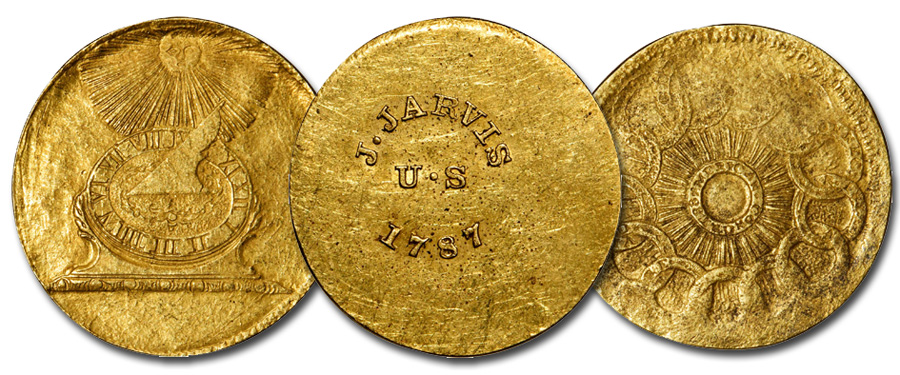
Our May 2019 Baltimore Auction will feature an exceptional selection of United States colonial coinage, including many popular issues and an impressive set of New Jersey coppers from the Collection of Larry L. Terrell. Highlights of our colonial offering include a pair of unique gold impressions of Newman 102-GG, considered to be from the original "five parts of the dies" obtained by Horatio Rust in New Haven in 1859. These impressions are thought to have been produced in the first half of the 20th century. They are now both certified MS-62 by PCGS. There are no known die-struck coins from the Newman 102-GG dies, although a bronze hub impression was offered in our October 2003 sale of the Ford Collection, Part I, and a gold trial piece made from this hub was sold in our November 1988 sale of the Norweb Collection, Part III.
These uniface gold impressions are significant rarities pertaining to the Fugio series that have drawn the attention of colonial specialists including Newman, Ford, Breen, and Boyd. The earliest mention of these pieces is in a letter dated February 28, 1955, from John J. Ford, Jr. to Eric P. Newman, where Ford writes that he has "just seen [an] obverse and reverse struck on gold planchets from very rusty dies" and goes on to describe the JARVIS reverse.
It would be several years later that Eric Newman would finally examine the gold impressions offered to be offered in our May 2019 Baltimore Auction. On July 4, 1958, John Ford, Eric Newman, and F.C.C. Boyd met for a numismatic summit of sorts at the Biltmore Hotel in New York City, where they shared coins from their collection and loaned each other pieces to study. Among the many rarities accompanying Newman were four pieces of Somers Island coinage and a 1776 Continental dollar in silver. Newman made handwritten notes on Biltmore stationary about several colonial coins brought by Boyd, including his own 1776 Continental dollar in silver and this pair of uniface gold Fugio impressions.
These impressions were held privately as part of the F.C.C. Boyd Estate for much of the 20th century, but gained recognition by modern numismatists. In the July 1983 issue of The Colonial Newsletter, Jim Spilman mentions an assortment of Fugio trial pieces including "uniface replications in gold bearing the name J. Jarvis on the backside," which were not made by Sylvester Crosby circa 1902, but "by others at some later date." Perhaps the most impactful mention of these pieces was in Walter Breen’s Complete Encyclopedia (1988) under the numbers 1329 (obverse) and 1330 (reverse).
Impressions of Newman Obverse-102 are truly significant rarities and any Fugios in gold are even more desirable. The present example represents an important opportunity that has eluded the past several generations of numismatists and may not occur again for quite some time.
Our May 2019 Baltimore Auction will be available for viewing and bidding on our website www.stacksbowers.com, or you may contact our offices to secure a printed catalog. To speak with a numismatic representative, please call 800-458-4646 or email info@stacksbowers.com. Also, download our mobile app to view and participate in our auctions via your Android or Apple device..





